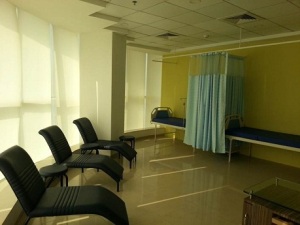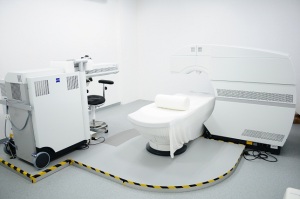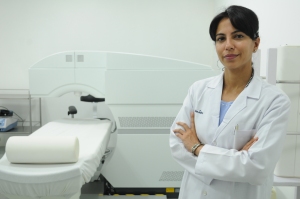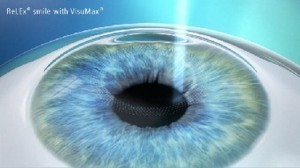In the earlier two blogs on pre-Lasik evaluation we discussed the importance of measuring corneal thickness and corneal topography prior to considering LASIK. In this blog we will understand the importance of some of the other measurements.
Suniti visited me at the Center for LASIK surgery at Advanced Eye Hospital and Institute in Navi Mumbai, India. She had got her LASIK laser vision correction done 2 years back in Mumbai. She had beautiful blue green eyes. She was getting troubled by the glare and haloes at night. Her power prior to the surgery was -4D. The power was not very high and by itself not enough to contribute to the glare problem at night. There can be several factors which contribute to night glare like large pupil (small round black front aperture which allows light to enter the eye) in dim light, dry eyes, presence of ocular aberrations and smaller zone of laser treatment. In her case there was a striking difference between the zone of her laser treatment on cornea and pupil size in the dim light conditions. Her pupil was quite big in dim light but her lasik laser had been done in a smaller area only in centre. When I explained the reason to her, on one hand she was reassured that there was no complication but on the other hand she was disturbed that why these measurements were not performed prior to the Lasik surgery. Irrespective of the type of laser vision correction procedure such as conventional Lasik or bladeless Femto LASIK or ReLEX SMILE Lasik, these measurements help plan the best type of LASIK surgery for the patient, understand the results, counsel the patients and set the expectations. Some measurements like pupil diameter, corneal diameter, eye ball length are a very important part of Pre-Lasik evaluation
- Pupil Diameter– It is very important to know the pupil diameter in normal light conditions and in dim light conditions. Some people especially those with light colored eyes (iris) have large pupil in dim light conditions. If the zone of laser treatment during LASIK surgery is smaller than the scotopic (dim light) pupil diameter, then at night, light will enter the eye from 2 different zones. One from the laser treated zone on cornea and one from untreated cornea. This phenomenon leads to night vision issues like glare and halo etc. So knowing the pupil diameter is very important to plan the LASIK surgery better. Either we can plan the larger optical zone of laser treatment or we can chose other modes of treatment like smart aberration profile with larger transition zone or wave front guided treatment etc.
- Corneal Diameter– This is measured to know the horizontal extent of the cornea (front transparent part of the eye). Laser vision correction procedure is done on cornea and it is the change in the corneal curvature which reduces the eye power. Corneal diameter helps us in making a decision about the size of the microkeratome suction ring in cases of conventional LASIK, or the size of the cup that we choose during bladeless femto lasik or ReLEx SMILE lasik. For example a smaller cornea will require a smaller ring and a smaller suction cup. Corneal diameter can be measured manually using manual or digital calipers or by the corneal topographer or the IOL master machine
- Size of two eye balls– Ridhi is a Biomechanical engineer and lives in Mumbai. She wanted to get the best Lasik done. During her pre Lasik evaluation at the Center for LASIK surgery at Advanced Eye Hospital and Institute in Navi Mumbai, she took keen interest in all the tests and the machines that were used for those tests. When we were checking her eye ball length, she got very confused and enquired regarding the need for measuring the eye ball length before lasik. She asked “Isn’t the laser vision correction procedure performed on the cornea?”. I was very impressed by the depth of her thinking. She was absolutely right. It has no direct bearing on the Lasik surgery technique for most patients. But a few of us have very different eye powers in both the eyes. If the reason for different powers in both eyes is longer eye ball length in one eye then we may need to modify the planning for Lasik laser vision correction. Otherwise it can cause difference in image size between the two eyes after the laser vision correction procedure.
Length of the eye ball can be measured by either the eye ultrasound machine called A-scan or with the help of IOL master.
- Depth of the Anterior chamber (front part of the eye) – Again this is one of those measurements which has no bearing on the laser vision correction procedure. However this is the measurement I need to know if I have to suggest an alternative procedure like ICL (Implantable contact lens) for someone who is not suitable for laser vision correction procedures. Rahul had come to the Center for LASIK surgery and had a power of -16D in both eyes. This much power cannot be safely corrected by even the best of the LASIK laser vision correction procedure. Luckily for him, the depth of the anterior chamber was 3.2mm. This was in the normal range and he successfully underwent ICL implantation in both the eyes and now enjoys a life free from glasses.
It is often said that we cannot plan if do not analyze and measure. This is no less true for pre Lasik evaluation. So even though the whole pre-Lasik evaluation takes up to 2 hour but it is required for proper planning, and better counseling, to get best Lasik surgery results and to ensure long term safety.
About Dr. Vandana Jain–
Dr Vandana Jain is an expert Cornea and Lasik surgeon. She has vast experience of performing laser vision correction procedures over a decade. She is well versed with all the latest techniques and advancements in laser vision correction procedures like LASIK, Femto Lasik, Smile Lasik, PRK etc. Dr. Jain ensures that all the patients undergo a detailed pre Lasik evaluation and then the best procedure and the technique is chosen for the patient to get satisfying results and to ensure long term safety.
About Center for Lasik Surgery at Advanced Eye Hospital and Institute, Navi Mumbai- 


 Center for Lasik Surgery at Advanced Eye Hospital and Institute is one of the best lasik surgery centers, a modern well-equipped advanced center for all those who wish to get laser vision correction procedure done. A very detailed protocol based and meticulous pre-Lasik evaluation is done for all the patients. The advanced equipments like corneal topographer, corneal tomographer, IOL Master, A scan, B scan and OCT machines help us in detailed measurements. The aim is to choose the best procedure for all the patients. AEHI caters to patients from all over Navi Mumbai such as Vashi, Nerul, Kharghar and Panvel besides people traveling from all over western India.
Center for Lasik Surgery at Advanced Eye Hospital and Institute is one of the best lasik surgery centers, a modern well-equipped advanced center for all those who wish to get laser vision correction procedure done. A very detailed protocol based and meticulous pre-Lasik evaluation is done for all the patients. The advanced equipments like corneal topographer, corneal tomographer, IOL Master, A scan, B scan and OCT machines help us in detailed measurements. The aim is to choose the best procedure for all the patients. AEHI caters to patients from all over Navi Mumbai such as Vashi, Nerul, Kharghar and Panvel besides people traveling from all over western India.
Watch Dr Vandana Jain, Cornea and Lasik Specialist perform SMILE Lasik – the most advanced and the best laser vision correction surgery in the world. Watch Dr Vandana Jain, Harvard trained Cornea & Lasik Surgeon at Advanced Eye Hospital and Institute (AEHI) in Navi Mumbai, India answer frequently asked questions on SMILE laser vision correction surgery





